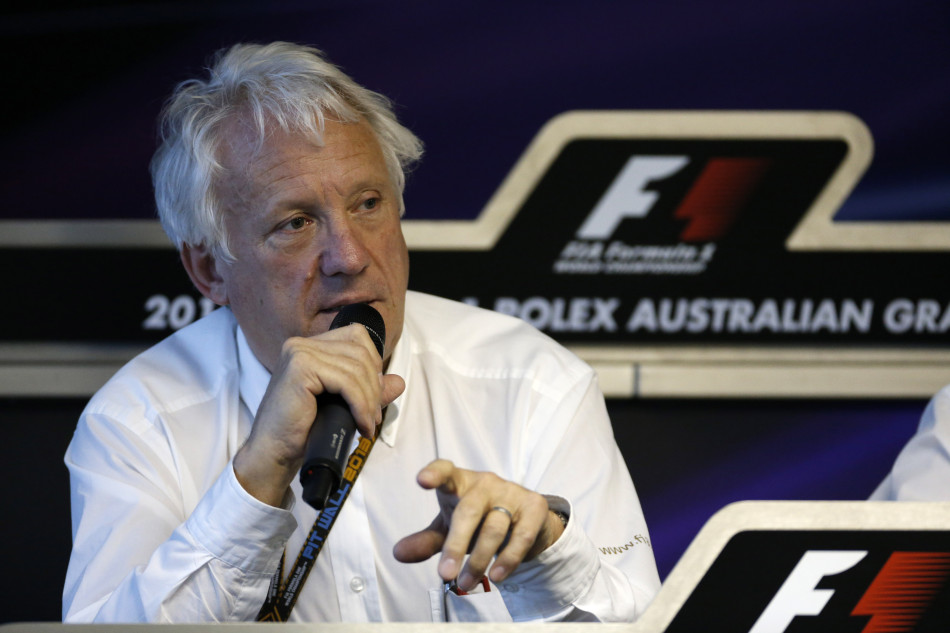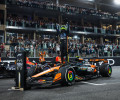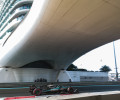F1 Race Director's 2014 Technical Briefing

Synopsis of FIA Race Director Charlie Whiting’s media Q&A session Australian Grand Prix, Thursday 13th March, 2014.
Sporting regulations
Extra qualifying tyres
In order to encourage everybody to go out in Q3 – which was perceived as a problem sometimes –an extra set of Option tyres will be provided. They will be used by the drivers in Q3 and cannot be used before. Q3 drivers – whether they use that set or not – have to hand them back after the Q3 session.
Drivers that didn’t make it into Q3 can use this extra set during the race – it’s a little bonus for those who didn’tt make it into the final part of qualifying.
The other key point is that the drivers who qualify for Q3 will start the race on the tyres with which they set their best Q2 time [assuming a dry qualifying/race].
Additionally, Q3 has been lengthened by two minutes [to 12 minutes] and Q1 has been shortened by two minutes [to 18]. The idea of making Q3 a little longer was to ensure any driver who wants to has time to make two runs.
Extra tyres for FP1
There is an extra set of Prime tyres for the specific purpose of running during the first 30 minutes of the first practice session. The P130 set – as it is known – cannot be used after the first 30 minutes of the session have elapsed. Cars have to be back in the pits before that point is reached. The tyres will then be returned to Pirelli.
Five-second penalty
The five-second penalty was introduced to have a penalty that lies between a reprimand and a drive-through. It was felt is could be best served immediately before the wheels are changed in a pit stop. When a driver makes a pit stop, he comes to a halt [in his pit box] and the crew cannot work on the car for the first five seconds. It is a straight five-second penalty.
A driver given a five-second penalty must take it the next time he makes a pit stop. If he doesn’t make a pit stop, then five seconds will be added to his time at the end of the race. In this situation the time-keepers will amend the classification during the slowing-down lap and the timing screens will be refreshed to reflect that.
107 per cent rule [in context of 2014]
The 107 per cent rule was introduced to make sure teams would not get into the race if they were not capable of producing a good car of the required performance. The situation at the moment is that we have 11 teams we know are capable – but some may be suffering a temporary performance loss. I’m sure the stewards will look very sympathetically on any team that doesn’t qualify within 107 per cent of the fastest Q1 time. There is a mechanism within the rules to allow their inclusion under exceptional circumstances. It doesn’t always have to go on the criteria of a driver setting a suitable time in a previous session.
We have 11 very professional Formula One teams. If they have that sort of problem I’m sure there would be a very good reason for it. If they don’t complete any laps at all, I think the stewards might think that’s a little too far – but it’s not for me to say. The idea is that the stewards will do everything they can to make sure that everyone takes part in the race – but obviously they’ve got to use their best judgement also.
Fuel flow/fuel consumption
All cars are fitted with an FIA-homologated fuel flow sensor. It will not limit the flow, it will only monitor the flow. 100kg/hr is the maximum allowed fuel flow and I’m sure that teams will be close to that whenever they can be.
100kg of fuel can be used from the moment the lights go out to the point at which cars cross the line to finish the race. It is a maximum.
If the limit is exceeded, there is no tolerance [and drivers will be excluded from the classification]. We are confident in the meter’s accuracy but it will always be correlated with data we have from injectors to ensure there isn’t a wide divergence. From what we’ve seen so far, that won’t be the case.
Any potential over-use would be investigated after the race. It will be no different to any other technical check.
Grid composition when times not set
In the first instance nothing has changed. It will be based on whether they managed to leave the pit lane and do one lap, two laps etc. Where drivers have identical records then they will be assembled in the order of their times in the previous session – so in Q3 it will be based on Q2 times, Q2 on Q1 and Q1 on FP3. Obviously the old numerical system is no longer applicable [as drivers have personalised numbers].
Track limits
Track limits have become a very emotive subject. Fundamentally, a driver is required to use the track at all times. If any part of the car remains within the boundaries of the white lines, he is deemed to be using the track. If he has all four wheels over the white lines, he’s off the track.
A driver is allowed to leave the track and rejoin without penalty, providing he does so safely and providing he does not gain an advantage. It is up to us to decide whether he has gained an advantage from being off track.
Circuits are designed so that going off track should always be slower – or at least not faster.
My view is that if you have two wheels on a bumpy kerb and two on artificial grass, that is not faster. Not everybody shares that view but it is held by the majority. In Jerez, we held a meeting with the drivers to discuss the matter. They agreed with the general point of view but argued that there are certain corners on certain circuits that require special treatment. Therefore we will treat each circuit individually rather than making a blanket ruling.
Marshalling system
We have a much-improved marshalling system that will give us much better accuracy when looking at car positions and track sectors. We can now split the track into 20 sectors rather than the traditional three. It will allow us, for example, to check accurately that a driver has slowed appropriately for yellow flags where looking at the larger sector would not always be representative. It’s another tool that’s been added to the Stewards’ armoury.
Technical Regulations
Low noses, crash-structures, marginal cross-sections
I do not agree [with the perception] that teams have circumvented the rules. I think a lot of teams have come up with a solution that is not quite what we intended. [Nose tips] are less structural than we would have liked but the fully structural part of the nose is significantly lower than it was last year – on average 200mm lower. This is going to be a significant [safety] improvement over last year. [The implementation] has perhaps has not worked as well as we hoped it might. This will be addressed for next year.
Roll hoop warning lights
These work when the car is stopped and in the pit lane. They provide information on the status of ERS.
‘Lift and coast’
If the torque management system on the car decides to go into a fuel-save mode, the rear light will flash for a second to warn any driver behind. The thresholds are configurable but currently set for a car above 95 per cent throttle for more than a second, travelling faster than 180kph, that experiences a torque reduction of 120kW or more.
The warning system has been created because these events are controlled by the electronics rather than by the driver. If the driver decides to back off early then the situation is as it always has been. He has a responsibility to ensure another car is not close behind him. It’s as simple as that. One would normally expect the driver to check that it’s OK to back off. The warning light is there for situations not controlled by the driver.
Power unit homologation
The rules are identical to those used previously. Power units are homologated. Each manufacturer had to provide a reference power unit on February 28th 2014. The power units have to stay in that homologated specification for the rest of the year. The exceptions are for changes required for the reasons of safety, reliability or cost-saving.
The procedure for making a change under these criteria is for the manufacturer to make a request to us in writing. We then share that information with the other power unit manufacturers. This is not for their approval, merely so that they are aware and able to comment on anything they believe is relevant. After this consultation process it is up to the FIA to decide [if the change is acceptable].
In the two weeks following the power unit homologation date, each of the manufacturers has used this process.
Thermal stickers
The rules state tyres have to be operated within the limits the manufacturer prescribes. We have been monitoring tyre pressures and end-of-straight cambers. This [temperature in the tyre blankets] is another parameter they have asked us to check this year.
There are limits set by Pirelli, they want minimum starting pressures and maximum end-of-straight cambers and for this year they do not want to see tyres heated in the blankets above a certain temperature. They have added temperature [sensitive] stickers to the tread that change colour if the specified maximum temperature is exceeded.
Manual rear brake reliability
We have covered this by having a maximum difference between the master cylinder sizes [for front and rear]. Teams using brake-by-wire on the rear brakes may have been tempted to use a largely superfluous master cylinder for the rear. By specifying a difference of no more than 2mm we ensure there will be a genuine working system – as is required in the rules. Should the brake-by-wire system fail it may not be quite as efficient but it will not endanger the driver or other drivers around.
General Racing
Whole field retirement
I think a lot of these doomsday scenarios are quite unlikely, knowing Formula One teams and how efficient they actually are.
If it came to a situation where no cars were running, I think the only option we would have would be to stop the race. If the race could not subsequently be restarted, as the rules make clear, then the result would be declared, based on the order one lap prior to that in which the race was stopped. Whoever was leading at that time would be declared the winner. I stress, I think it’s highly unlikely, given the professionalism of the teams.
Safety Car deployment in high attrition race
It will not affect the use of the Safety Car at all. If a car stops and it’s in a dangerous position, we will use the Safety Car as normal. We cannot do anything else. I do not think there is any need to change the Safety Car procedures or how we go about operating the Safety Car.
Long rebuild times, FP3 issues and qualifying
This is not a concern to me. There is a two-hour gap between FP3 and qualifying. It would be unfortunate if a team had a problem in FP3 and could not fix it before qualifying – but it is not without precedent.
Teams are worried this might be a common occurrence, I have heard some say they would consider skipping FP3 to ensure they had a car ready for qualifying. Everyone has their own method of working. Some teams tell me it takes seven hours to change an engine, some say three hours, others say 90 minutes. We don’t know, and we don’t know whether such difficult situations will arise. Compared to what we’re accustomed to, I’m sure things will be a little different during the first three or four races. We will have to wait and see – I have no real feeling for what’s going to happen.
Research
This year each driver will have a three-axis, in-ear accelerometer fitted in each ear. This will give us information about exactly what is happening to a driver’s head in the event of an accident. This will be correlated with the high-speed video that we’re going to use in the onboard cameras. This is research being done by the FIA Institute in order to better understand the mechanisms of accidents.

 Facebook
Facebook Twitter
Twitter






